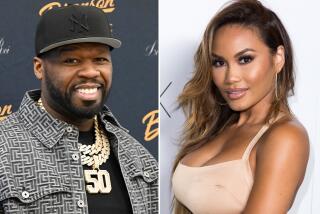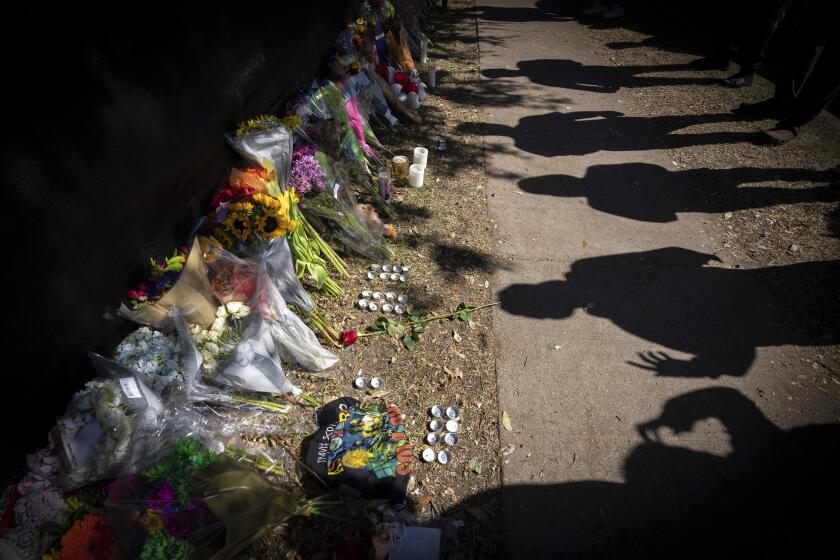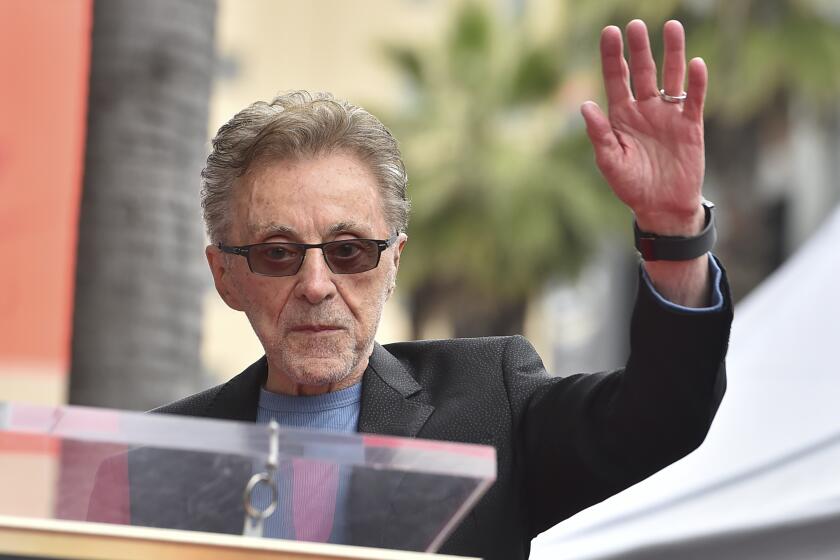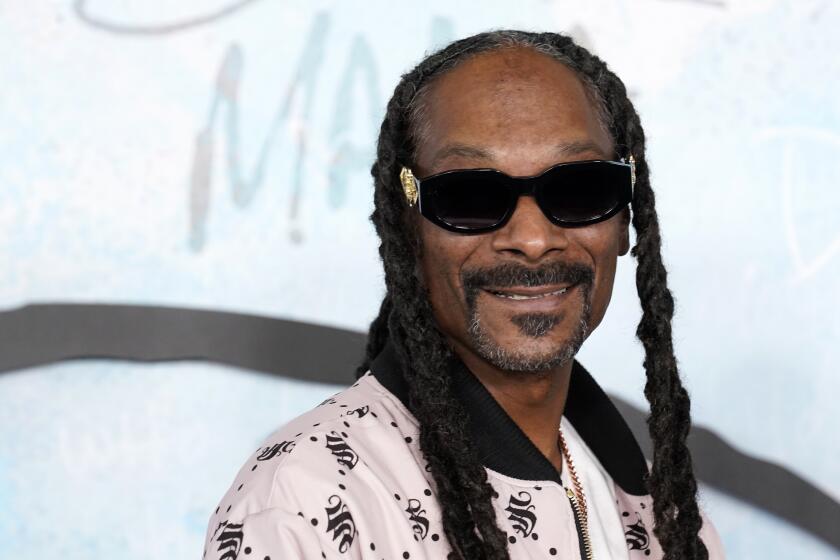Elvis Has Left the Building, but James Burton’s Still Performing
Elvis is gone. But James Burton is still taking orders from him.
When the King of rock ‘n’ roll hovers over him, almost celestially, in the synced-up films of the disarming “Elvis--The Concert” tour, and shouts out, “Play it, James!” Burton does his bidding.
And although the Elvis footage that dominates the shows is all on tape, the picking is all live by Burton and the rest of the original Elvis Presley band from the 1970s, re-creating a concert experience by the king two dozen years after his death.
“It’s real, and that’s what’s so great about it,” says Burton, 61, over the phone from his Louisiana home before embarking on the tour. “The memories of Elvis live forever, and the music is so wonderful to play. It’s very enjoyable. And it’s great to present it to the public live.”
For people who never saw Presley at his performance prime--and for those who want to rekindle the memories--the show is striking. It mixes Elvis singing on film with the members of the band--Burton and the other originals: Glen D. Hardin on piano, Ronnie Tutt on drums, Jerry Scheff on bass and musical director Joe Guercio, accompanied by the original Sweet Inspirations backing vocal group--all wailing, alive and well, on stage.
It is a little strange to be tied so tightly to the synchronized screen, says Burton, who backed the real thing from 1969 to 1977.
“You have to pay attention,” he says. “You don’t want to miss your introduction. But once you’re off, man, it’s great. It’s fun to do.”
There might not be much spontaneity in the show, but neither is there the worry of what song will come next. “You never knew what he’d do next,” Burton says of Elvis’ concerts in the late ‘60s and early ‘70s. “He’d put a set list out there, but you could forget that. If he did the first three songs on it, you’d be lucky.”
Burton, a 2001 inductee into the Rock and Roll Hall of Fame, first got a call to work with Elvis for his 1968 comeback TV special. “I was doing a Frank Sinatra album and was not available.”
But once that telecast was over, Presley called again, Burton says in his easy drawl. “Elvis called me personally and told me he didn’t want to do movies anymore, he wanted to do music and perform live. And he asked me if I’d be interested in putting a group together to back him.
“I thought about it for about a minute.”
At the time, Burton was hugely in demand in the studio, having played on scores of hit records after making his name backing Ricky Nelson for years.
Burton had made his mark on rock ‘n’ roll even earlier, coming up with the trademark swampy guitar lick that made a hit out of Dale Hawkins’ “Suzie Q.”
“I was 15,” Burton says. “It was a little instrumental thing I played. When I met Dale Hawkins, he had a blues band. I played this instrumental thing in different places we’d play, and it became so popular--it had such a good dance feel, with a good funky beat in there--Dale said, ‘I need to write some lyrics to this.’ So Dale did.”
Burton helped make “Suzie Q” a 1957 hit before he even had a driver’s license.
While still a teenager, Burton began backing rockabilly singer Bob Luman, who appeared on the famous “Louisiana Hayride” broadcast, usually when Elvis wasn’t in town, so Burton never did cross paths with Presley during those early days.
Burton’s twangy guitar tones were distinctive even then.
“I grew up on country music and then moved into rhythm and blues,” Burton says. “I created my own style and idea from playing a mixture of this and a mixture of that. But R&B; and country is a great combination. You hear both in a lot of styles even today.”
He was enamored with the guitar styles of Chet Atkins, Merle Travis, Chuck Berry, Lightning Hopkins and Elmore James. “Out of that became my identity,” he says. As for his singular technique, he says, “I was using finger picks and one day playing something in a Chet Atkins style or Merle Travis style. Most guitar players use a thumb pick. But what I did was try one day to use a straight pick, then I used a finger pick.
Handpicking His Gigs
“Because I used to play a little slide and dobro with a bar, I got the touch of playing electric guitar with that finger pick and getting that sound, getting that edgy sound you don’t get with your fingers. That became my identity, my style in finger-picking.”
Because Luman was on Liberty Records, Burton got to meet Ricky Nelson, who was recording in an adjacent studio. Nelson liked his style.
In fact, Nelson hired Burton, who was about his age, to front a band that backed him for nine years in recordings, concerts and on TV, where weekly exposure on “The Adventures of Ozzie and Harriet” made Nelson an instant sensation with hits like “I’m Walking,” “Believe What You Say” and “Lonesome Town.”
Although Nelson was seen by some people as a teen idol pretender to the Elvis throne, “I think he did have a feel for it,” Burton says. “It was interesting to play music with him. He loved the rockabilly style I used with Luman. He loved that energy. But we did so many different styles, from pop to R&B; to country to a Ray Charles ballad. It was great.”
Burton got noticed as a peerless rock guitarist on TV and was invited to play on Johnny Cash’s 1964 series before being invited to put together a house band for the “Shindig” show, the Shindogs.
“We backed so many artists on that show,” Burton says. That led to a lot of studio-session work. His work appeared on recordings by the Everly Brothers, Beach Boys, Jan and Dean, the Fifth Dimension, Sonny and Cher, the Monkees, “you name it,” Burton says.
He wasn’t just a player for Top 40 pop. He also played on the more standard recordings by Sinatra, Sammy Davis Jr., Nat “King” Cole and Charles.
And he was popular also in Nashville where he backed Merle Haggard, Buck Owens and Wanda Jackson, among others.
It was through these associations that led to some of Burton’s most rewarding work. “Through working with the Byrds, I met Gram Parsons,” Burton says. “We cut some wonderful stuff.”
Then he went on to back Parsons’ harmony singer, Emmylou Harris, as a member of her original Hot Band, an assignment he fit in between his main gig, backing Presley on stage and in the studio.
Among his other gigs over the years were backing the other Elvis--Costello--on the “King of America” tour, and touring with Jerry Lee Lewis.
*
Roger Catlin is rock music critic for the Hartford Courant, a Tribune company.
More to Read
The biggest entertainment stories
Get our big stories about Hollywood, film, television, music, arts, culture and more right in your inbox as soon as they publish.
You may occasionally receive promotional content from the Los Angeles Times.






